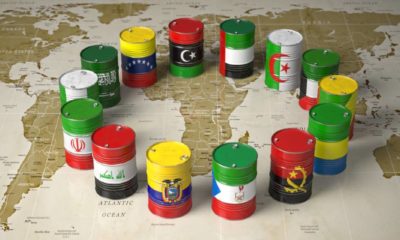Business
Oil Prices Rise With Nigerian And Canadian Disruptions

With U.S. oil supplies growing and production still going on, oil prices went way down. Some consumers were getting gas at less than $2 per gallon. These are prices nobody noticed for quite some time.
Oil went way down for a time, closing at $27 per barrel at its lowest point. This price was back in February. Prices rose somewhat steadily for a time, and prices hit a little over $46 today at closing. Brent crude futures closed right at $47 today.
A Volatile Period
Oil prices have been quite volatile this year, moving up and down, and all around, it seems. Some experts say that oil price fluctuation is far from over. Prices have risen somewhat for several reasons recently, but it is unknown how high it will go and for how long.
The Canada Situation
Canadian Oil Sands in Fort McMurray, Alberta, have recently seen some serious troubles. A wildfire that grew massive in a very short time is still raging out of control, but the danger seems to be away from work sites, allowing workers back in again. There was a temporary suspension of the operations for a week, but workers heading back will soon have production moving along.
The U.S. Situation
The EIA (Energy Information Administration) issued a report about U.S. inventory falling. U.S. stock went down by almost 3.5 million barrels. This plunge in stock prices also added to the increase in prices. Demand has been higher this year, and more so than expected by analysts.
The Nigerian Situation
Oil production in Nigeria dropped off after Nembe Creek Trunk Line went down. Repairs were necessary to the line after they found the leaks. These repairs brought down Bonny Light production and were a major blow to Nigeria’s already struggling economy.
The reason it hits so hard is that Forcados crude is still down. Leaks in the underwater pipeline forced production to cease. One can expect that Forcados will be able to resume production in June. Shell Petroleum Development Co operates the Nembe Creek Line and has not said when production will resume there as of yet. SPDC is part of Royal Dutch Shell.
[ms_divider style=”normal” align=”left” width=”100%” margin_top=”30″ margin_bottom=”30″ border_size=”5″ border_color=”#f2f2f2″ icon=”” class=”” id=””][/ms_divider]
[ms_featurebox style=”4″ title_font_size=”18″ title_color=”#2b2b2b” icon_circle=”no” icon_size=”46″ title=”Recommended Link” icon=”” alignment=”left” icon_animation_type=”” icon_color=”” icon_background_color=”” icon_border_color=”” icon_border_width=”0″ flip_icon=”none” spinning_icon=”no” icon_image=”” icon_image_width=”0″ icon_image_height=”” link_url=”https://offers.thecapitalist.com/p/58-billion-stock-steal/index” link_target=”_blank” link_text=”Click Here To Find Out What It Is…” link_color=”#4885bf” content_color=”” content_box_background_color=”” class=”” id=””]This one stock is quietly earning 100s of percent in the gold bull market. It's already up 294% [/ms_featurebox]
[ms_divider style=”normal” align=”left” width=”100%” margin_top=”30″ margin_bottom=”30″ border_size=”5″ border_color=”#f2f2f2″ icon=”” class=”” id=””][/ms_divider]
Other Issues Causing Price Rise
Nigeria and Canada were not the only contributors to a boost in oil prices. Some Latin American producers along with Asian, African, and North American have experienced some issues with production going down and other disturbances. These have all factored in on the resurrection of oil prices.
Before we get to the Middle East situation, let’s recap so far.
- Oil prices have rebounded, closing at $47 per barrel in Brent futures market
- Production drops from several causes have led to rising prices
- Growing demand also contributes to
- Canadian Oil Sands production slated to resume shortly after week-long shutdown due to wildfires in Fort McMurray.
- Nigerian production hit hard by Nembe Creek Trunk Line closure
- Price rise also helped by increase in demand
The Middle East Situation
It seems there is always something going on in the Middle East, and that is because there is. Right now, oil producers in the Middle East could very well cut the legs out from under this rebound in oil prices.
Iran has increased its production beyond analyst expectations. This increased production was due chiefly to the lifting of the export sanctions. Saudi Arabia is the dominant player in what could bring oil prices down even further.
Saudi Arabia has publicly stated that its production will not only continue, but it will increase further with expansion. Saudi Arabia is tops among OPEC cartel producers, and none of them have agreed to slow down their production, despite pleas from other nations to do so.
Saudi Arabia is going for market share rather than prices at the moment, and Aramco, the monopoly oil company in the country, is going for it all, increasing production at all sites. Playing a part in this was Aramco’s chairman becoming Saudi Arabia’s new veteran oil minister.
Another important element in the unchecked production comes from Prince Salman. He is very much for getting market share, making it more important than the price at the moment. The kingdom has the capital to keep producing at high levels while prices are low, plus they still profit from exports.
There was almost a done deal that would bring prices skyrocketing upward again, but that deal was on the back burner. The deal would have made a global supply freeze, which would be the driving force in rising prices. Prince Salman was believed to have played a pivotal role in the deal falling apart.
What it All Means
Again, oil prices have come back up, but further fluctuations and even further drops in price could come soon with Middle East production continuing, with Saudi Arabia giving the biggest contribution to the effort.
If the oil prices continue to decline, it is expected that many countries will make an honest effort at getting off of Middle Eastern oil. Falling dependence can counteract the continuous production effects on oil prices.
For a final recap, here’s what’s been happening.
- Oil prices have risen to $47 per barrel, with $27 being the year-low back in February
- Production disruptions in Canada, Nigeria, and other countries have played a role in price rise
- An attempt to implement a global freeze deal to boost prices has failed
- OPEC, with Saudi Arabia at the top, has continued production and planned to increase it
- Iran’s export sanctions are gone, allowing them to increase production as well
- Alternative energy will likely be the chief weapon used to combat the effects of Middle Eastern production increases















